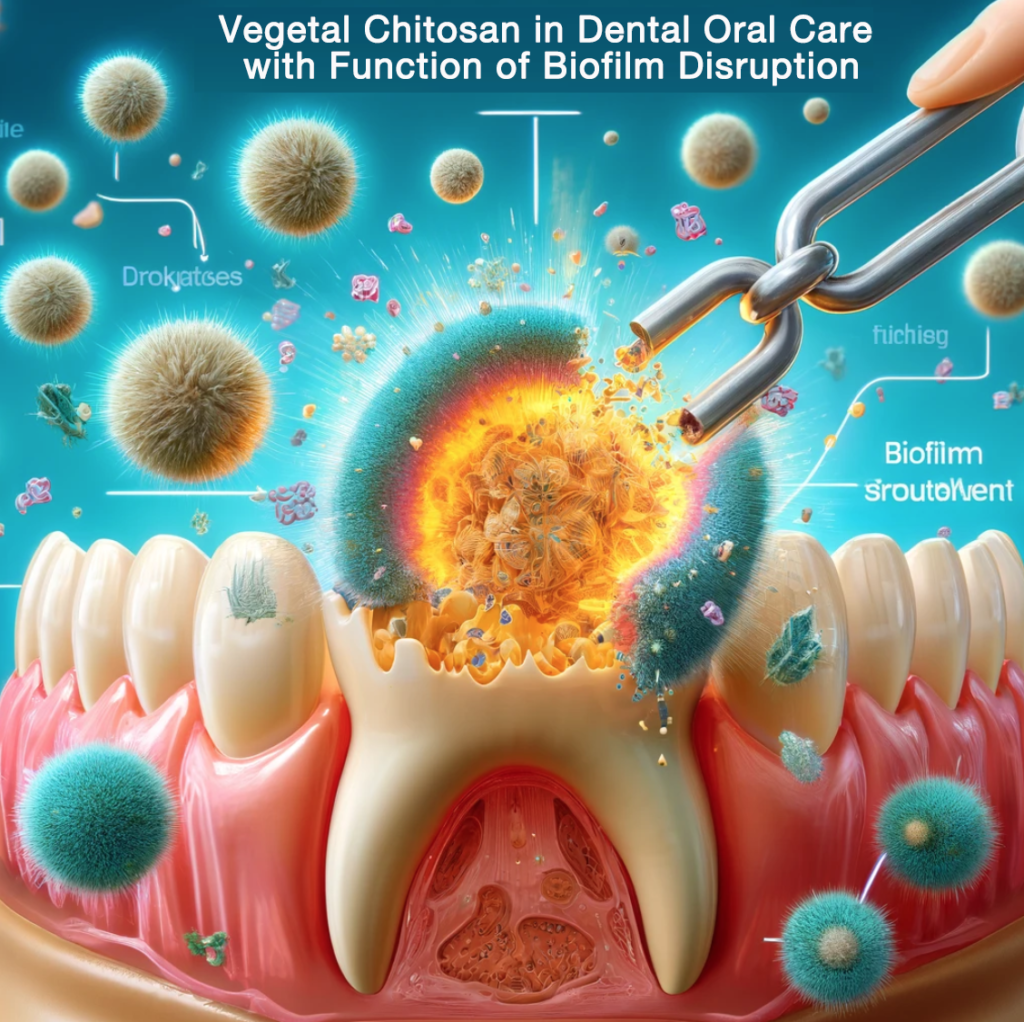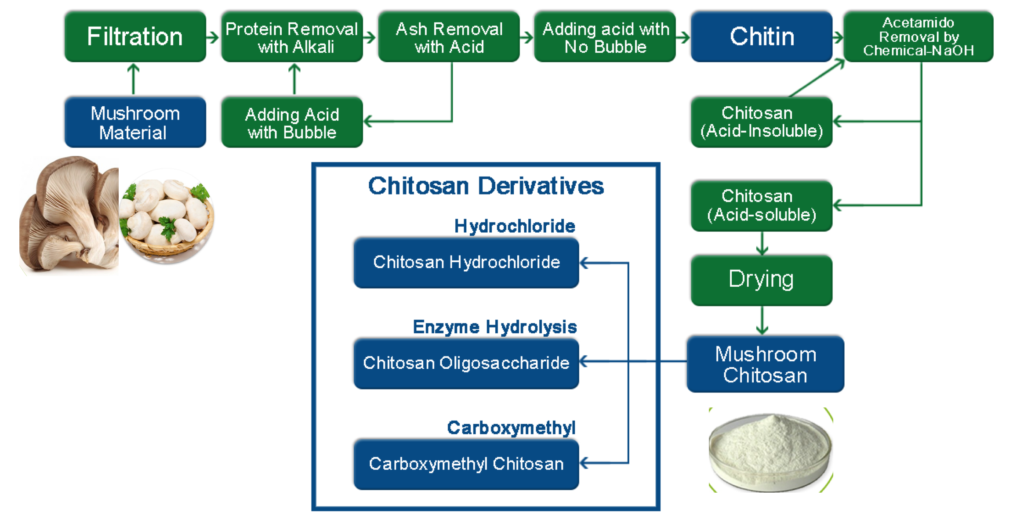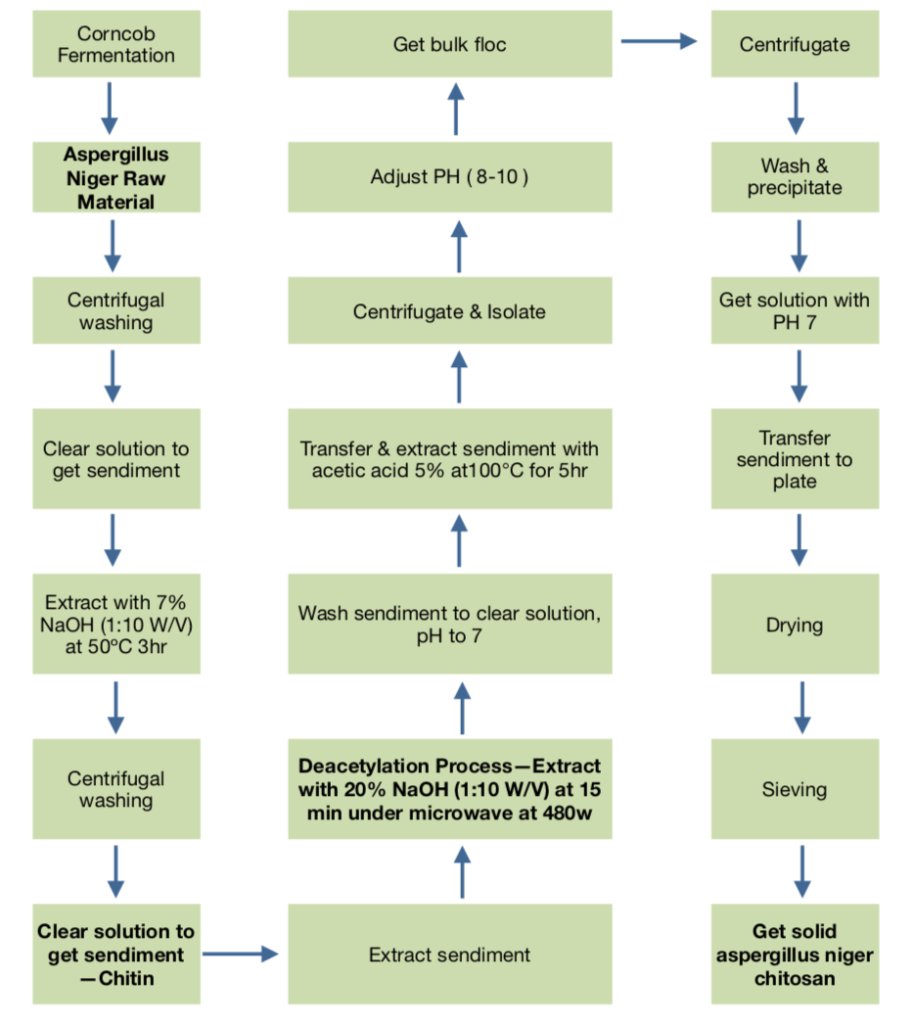1. What is vegetal chitosan?
Chitosan is a natural biopolymer that is primarily derived from chitin, which is the second most abundant natural polysaccharide after cellulose. Chitin is commonly found in the exoskeletons of crustaceans like crabs, shrimps, and lobsters, as well as in the cell walls of certain fungi like mushroom, aspergillus niger.
Structure and Properties:
- Chemical Structure: Chitosan is obtained by deacetylating chitin. This process involves removing acetyl groups from chitin, resulting in a polymer that has free amine groups.
- Solubility: Unlike chitin, chitosan is soluble in acidic to neutral solutions, making it more versatile for various applications.
- Biocompatibility and Biodegradability: Chitosan is known for its excellent biocompatibility and biodegradability. It’s non-toxic and can be broken down by natural biological processes.

Chitosan, sometimes known as deacetylated chitin, is a natural polycationic linear polysaccharide derived from partial deacetylation of chitin. Chitin is the structural element in the exoskeleton of insects, crustaceans (mainly shrimps and crabs shell), and cell walls of fungi (oyster mushroom, agaricus bisprous and aspergillus niger), and also is the second most abundant natural polysaccharide after cellulose.

Chitosan, a natural polysaccharide prepared of fungal origin, is initially extracted and purified from reliable and abundant food or biotechnological fungal sources such as Agaricus bisporus or Aspergillus niger.
Chitosan is composed of glucosamine sugar units (deacetylated units) and N-acetyl-D-glucosamine units (acetylated units) interconnected by ß→(1.4) type linkages.
Uses and Applications:
- Medical and Pharmaceutical Fields: Due to its biocompatibility and non-toxic nature, chitosan is used in wound healing, drug delivery systems, and as a biomaterial in tissue engineering.
- Water Treatment: Its ability to bind with heavy metals and other contaminants makes it useful in water purification and treatment processes.
- Agriculture: As a natural biostimulant and elicitor, chitosan is used to enhance plant growth and provide resistance against pathogens.
- Food Industry: It’s used as a food additive for its antimicrobial properties, and as an edible film or coating to enhance the shelf life of perishable food products.
- Cosmetics and Personal Care: In this realm, it finds use as a thickener, moisturizer, and film-forming agent, particularly in hair and skin care products.

Chitosan has been widely used in various fields, including wine, pharmaceuticals, dietary supplement, medicine, agriculture, and food industries, due to its biocompatibility, biodegradability, and non-toxicity. In recent years, researchers have investigated the use of vegetal chitosan, which is derived from fungal or plant sources, as a sustainable alternative for use in wine applications.
Variants:
- Traditional Chitosan: Traditionally sourced from marine crustaceans.
- Vegetal Chitosan: Derived from fungal sources, offering an alternative for those seeking non-animal derived products.
In summary, chitosan’s versatility, biodegradability, and non-toxic nature make it a valuable material across various industries, from healthcare to cosmetics. Its ability to be derived from non-animal sources also makes it an appealing option for vegetarian and vegan-friendly products.
2. What are the advantages of vegetal chitosan?
Vegetal chitosan, also known as fungal chitosan or mycelium chitosan, is a type of chitosan derived from the cell walls of fungi (mushroom and aspergillu niger). It has several advantages over traditional chitosan derived from shellfish, including:

- 1. Vegan and vegetarian-friendly: Vegetal chitosan is an excellent alternative for individuals who avoid animal-based products, such as those who follow a vegan or vegetarian lifestyle.
- 2. Allergen-free: Traditional chitosan is derived from shellfish, which can cause allergic reactions in some people. Vegetal chitosan does not contain any shellfish-derived ingredients, making it an allergen-free option.
- 3. Purer: Vegetal chitosan is often considered to be purer than traditional chitosan because it is derived from a single source, whereas traditional chitosan can be contaminated with other shellfish-related substances.
- 4. Better solubility: Vegetal chitosan is more soluble than traditional chitosan, which makes it easier to incorporate into various applications such as cosmetics, pharmaceuticals, wine and food.
- 5. Improved bioavailability: Some studies have suggested that vegetal chitosan has a higher bioavailability compared to traditional chitosan, which means that it can be absorbed and utilized more effectively by the body.
Overall, vegetal chitosan offers several advantages over traditional chitosan, making it an attractive alternative for individuals and industries looking for a vegan, allergen-free, and more effective chitosan source.
3. What are the benefits & functions of vegetal chitosan in dental & oral care?
Vegetal chitosan derived from sources like oyster mushrooms and Aspergillus niger presents several beneficial properties for dental oral care. Here’s a breakdown of its functions and benefits:
Benefits of Vegetal Chitosan in Dental Oral Care
- Reduction of Dental Plaque and Periodontal Disease: By reducing bacterial growth and disrupting biofilms, chitosan helps lower the risk of plaque accumulation and the onset of periodontal diseases

- Improved Wound Healing: Chitosan’s ability to support tissue regeneration leads to quicker and improved healing of oral wounds and surgical sites.

- Enhanced Efficacy of Oral Hygiene Products: With chitosan’s ability to bind and slowly release therapeutic agents, oral care products become more effective, offering prolonged protective effects against oral pathogens.

- Safe and Natural Oral Care: Being a biocompatible and biodegradable substance, chitosan provides a safe alternative to synthetic ingredients in oral hygiene products, minimizing the risk of adverse reactions.

- Anti-Inflammatory Properties: It helps in reducing inflammation in the gums, which is beneficial in treating and preventing conditions like gingivitis.

Functions of Vegetal Chitosan in Dental Oral Care
- Antimicrobial Activity: Chitosan functions to inhibit the growth and activity of various pathogens in the oral cavity, helping prevent infections and complications like tooth decay and gum disease.

- Biofilm Disruption: It can disrupt the structure and formation of bacterial biofilms on dental surfaces, which are a major cause of plaque buildup and dental caries.

- Carrier for Therapeutic Agents: Chitosan serves as an effective carrier or delivery medium for other active ingredients in dental products, enhancing their stability and effectiveness.

- Wound Healing Support: It facilitates the healing of oral tissues, aiding in recovery post-dental surgeries or from ulcers by enhancing cellular activities that promote tissue regeneration.

Research into vegetal chitosan’s applications in dentistry is ongoing, and these properties suggest it could be a valuable component in developing more effective oral care products.
4. What are the forms of vegetal chitosan in dental & oral care?
Vegetal chitosan can be incorporated into various forms of products for dental and oral care. Each form leverages the unique properties of chitosan to provide specific benefits to oral health.
The dosage or formulation guidelines for incorporating vegetal chitosan into dental and oral care products vary based on the specific application and desired therapeutic effect.
Here below are some common forms, its recommended formula guideline and which vegetal chitosan is used with better effectiveness:
- Toothpaste: Chitosan is often added to toothpaste formulations to enhance their antimicrobial and anti-plaque properties. It helps in the sustained release of active ingredients, improving the overall efficacy of the toothpaste in preventing dental caries and gum diseases.
- Chitosan Concentration: Typically ranges from 0.2% to 2% by weight.
- Application: Chitosan is incorporated into the base formulation of toothpaste to enhance antimicrobial activity and support the control of plaque and gingivitis.
- Suitable Chitosan Type: Chitosan Hydrochloride is commonly used in toothpaste because it is soluble in water, which makes it easier to incorporate into toothpaste formulations. It also has good antimicrobial properties which are essential for preventing plaque and gingivitis.

- Mouthwash: As a component in mouthwashes, chitosan can help reduce bacterial levels in the mouth, prevent the formation of dental plaque, and promote healthier gums. Its bioadhesive properties ensure that it clings to oral surfaces, providing a longer-lasting protective effect.
- Chitosan Concentration: Usually between 0.05% and 1%.
- Application: Used as an active ingredient in mouthwashes to exploit its bioadhesive properties for prolonged action against bacteria and for enhancing the repair of oral tissues.
- Suitable Chitosan Type: Chitosan Hydrochloride and Chitosan Oligosaccharide are both suitable. Chitosan hydrochloride for its solubility and bioadhesive properties, and oligosaccharides for their enhanced solubility and biocompatibility, making them gentle and effective in mouthwash formulations.

- Dental Gels: Chitosan-based gels are used particularly for their wound-healing and bioadhesive properties. These gels can be applied directly to the gums or on dental prostheses to aid in healing, reduce discomfort, and protect against microbial infections.
- Chitosan Concentration: Around 1% to 3%.
- Application: Dental gels containing chitosan are used for their wound healing properties, particularly after dental surgery or for treating periodontal pockets.
- Suitable Chitosan Type: Carboxymethyl Chitosan is ideal for dental gels due to its higher solubility and superior mucoadhesive properties. This type of chitosan can be very effective in forming gels that adhere to the gums or mucosa, providing a sustained release of active ingredients.

- Chewing Gums: Incorporating chitosan into chewing gum allows for the active components to be released slowly as the gum is chewed, aiding in the mechanical removal of food particles and plaque, while also delivering antimicrobial and healing benefits directly to the oral cavity.
- Chitosan Concentration: Chewing gums might incorporate chitosan at around 0.5% to 2%.
- Application: Chitosan in chewing gums helps in mechanically cleaning teeth while delivering antimicrobial agents effectively throughout the oral cavity over extended periods.
- Suitable Chitosan Type: Chitosan Oligosaccharide is beneficial in chewing gums due to its smaller molecule size, which can enhance its integration into gums and release active ingredients over an extended period as the gum is chewed.

- Dental Varnishes and Sealants: Chitosan is used in varnishes and sealants that are applied to teeth, either to prevent decay or as a treatment following dental procedures. These products form a protective layer over the enamel, releasing chitosan and other agents over time to strengthen teeth and reduce sensitivity.
- Chitosan Concentration: Typically around 1% to 5%.
- Application: These products use chitosan for its ability to form a protective barrier on teeth surfaces, slowly releasing therapeutic agents to aid in the remineralization of enamel and prevent decay.
- Suitable Chitosan Type: Acid-Soluble Chitosan is often preferred for varnishes and sealants because it can form durable, adhesive films that strongly bind to enamel and dentin. This form of chitosan is effective in creating a barrier against acid attacks and promoting enamel remineralization.

- Dental Films: These thin films can be placed on the gums or teeth to deliver concentrated doses of chitosan and other therapeutic substances directly to needed areas. They are particularly useful for targeted therapy, such as treating localized infections or promoting the healing of specific oral wounds.
- Chitosan Concentration: Can vary widely, typically from 1% to 3%.
- Application: These films are designed to release their active ingredients in a controlled manner, specifically targeting affected areas within the mouth.
- Suitable Chitosan Type: Carboxymethyl Chitosan is suitable for dental films because of its excellent film-forming ability and its enhanced solubility, which aids in better delivery and retention of therapeutic agents.

These various forms allow for the versatile use of chitosan in promoting oral health, each tailored to specific needs and treatments within dental care.
For all these products, the exact formula will depend on additional components such as flavoring agents, stabilizers, and other active ingredients intended to work synergistically with chitosan. Product development must also consider factors like pH, viscosity, and stability to ensure efficacy and consumer acceptance.
Developers should conduct thorough testing, including clinical trials where applicable, to optimize the formulation and ensure safety and effectiveness. Regulatory approval may also be required, particularly if the product is intended to make specific health claims.
Each of these chitosan derivatives offers unique properties that can be harnessed to improve the functionality and efficacy of dental products. It is essential to tailor the choice of chitosan to the specific needs of the product and the desired release profile of active ingredients.
5. What is the flowchart of vegetal chitosan processing?
The production process of plant chitosan is mainly obtained by extracting raw materials (mushrooms, Aspergillus niger), deproteinizing with dilute acid or alkali, deacetylating, drying, etc.
Here is a simplified flowchart of the production process of vegetal chitosan for your reference.

The flowchart of mushroom chitosan illustrates the process of producing chitosan and its derivatives from mushroom material. Here’s a summary of the key content:
- Starting Material: The process begins with mushroom material as the source.
- Filtration: The mushroom material undergoes a filtration process.
- Protein Removal: Proteins are then removed from the filtered material using an alkali solution.
- Ash Removal: Ash content is subsequently removed with acid.
- Chitin Extraction:
- Acid is added without bubbles to proceed to the next stage.
- Chitin is extracted, which is not soluble in acid.
- An acetylation step removes the acetyl groups from the chitin using sodium hydroxide (NaOH), converting it into chitosan, which is soluble in acid.
- Drying: The acid-soluble chitosan is then dried to produce the final mushroom chitosan product, showcased as a white powder.
- Chitosan Derivatives: Parallel to the drying process, there is a branch leading to the production of various chitosan derivatives:
- Chitosan Hydrochloride: Chitosan converted into its hydrochloride form.
- Enzyme Hydrolysis: Produces chitosan oligosaccharide through enzymatic hydrolysis.
- Carboxymethyl Chitosan: Derived through the carboxymethylation of chitosan.
The flowchart depicts a methodical approach to converting mushroom material into various forms of chitosan, focusing on the purification and chemical modification steps necessary to achieve different chitosan-based products for use in various applications.

The flowchart of aspergillus niger chitosan outlines the process for extracting chitosan from Aspergillus niger, a type of fungus. Here’s a step-by-step summary of the key points:
- Starting Material: Aspergillus niger is cultured through a fermentation process using corn.
- Extraction:
- The fungal biomass undergoes a bulk flocculation.
- This is followed by centrifugation to separate the components.
- The pH of the resulting material is adjusted to alkaline conditions (pH 8-10).
- Another round of centrifugation and isolation occurs.
- The pH is adjusted back to neutral (pH 7), and the sediment is washed and precipitated.
- The sediment is then extracted with 5% acetic acid at 100°C for five hours to get the clear solution.
- It is washed again to achieve a clear solution with a neutral pH.
- Chitin Production:
- The clear solution is treated with 7% sodium hydroxide (NaOH) at a ratio of 1:10 (W/V) at 50°C for three hours.
- Centrifugal washing follows, resulting in the production of chitin as a clear solution to get the sediment.
- Deacetylation:
- The sediment undergoes the deacetylation process. It’s treated with 20% NaOH at a ratio of 1:10 (W/V) and heated in a microwave at 480W for 15 minutes.
- This step is crucial to convert chitin into chitosan by removing acetyl groups.
- Final Steps:
- The final sediment, which is now deacetylated chitin or chitosan, is extracted.
- It undergoes drying, followed by sieving to achieve the desired particle size.
- End Product: The final product is solid Aspergillus niger chitosan.
This process includes several steps involving pH adjustment, centrifugation, chemical treatments, and heating, which are critical to ensuring the purity and quality of the chitosan extracted from Aspergillus niger.
6. In summary of vegetal chitosan in dental & oral care
Vegetal chitosan, derived from sources like oyster mushrooms and Aspergillus niger, has shown significant promise in enhancing dental and oral care products due to its unique biological properties.
This biopolymer is particularly valued for its antimicrobial capabilities, which help inhibit the growth of harmful bacteria, thereby reducing plaque formation, gingivitis, and periodontal diseases.
Additionally, vegetal chitosan’s ability to disrupt biofilms, which are protective layers formed by bacteria, further bolsters its efficacy in oral health maintenance. It also enhances the mechanical removal of food particles and plaque when used in formulations like chewing gums.

Furthermore, vegetal chitosan is employed in a variety of dental care products such as toothpaste, mouthwash, dental gels, and varnishes due to its bioadhesive properties, which extend the retention and effectiveness of therapeutic agents in the oral cavity.
Its biocompatibility and non-toxic nature make it a safe choice for regular use, contributing to its popularity in developing natural and effective dental care solutions.
The diverse application of chitosan in dental products, ranging from caries prevention to healing support after dental surgeries, highlights its versatility and potential in improving oral health care regimens.

